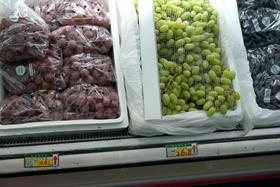
Chile’s fruit import market is at a transition point this month, with sourcing of grapes and apples moving over from Southern to Northern Hemisphere supply origins, and new-season citrus beginning to come in from key Southern Hemisphere sources.
South Africa is foremost among Southern Hemisphere citrus suppliers, and the industry will be hoping for a significant improvement on last year’s campaign, which was marred by sizeable losses.
The early-season citrus arrivals from South Africa have experienced contrasting fortunes so far this year, according to Jason Bosch, managing director of Origin Direct Asia.
“The South African grapefruit has gone from strength to strength, and I think that’s largely due to the limited volumes on the larger fruit. Similarly the lemons have been really good due to shortages from Argentina,” he said. “South African navels have had comparatively weak results. The fruit coloured late in South Africa forcing growers to wait for colour and now the internals are a little over-mature and the demand is poor.”
This comes on the back of a below par season for US citrus, he added. “Fruit from the US was weaker than we have seen historically; skin texture was rough and the fruit tended to be a little soft so the returns were pretty weak.”
As the South African citrus season moves into the all-important supply of Valencia-type oranges, Bosch said it will be very interesting to see how things play out over the coming months.
“On the positive side, there should be a limited amount of fruit arriving in China because the fruit sizing in South Africa is very small so if everyone abides by the required counts for the market there should be a drastic reduction in volumes,” he said.
“On the negative side, the Russian market is not ordering South African fruit and growers are forced to pack their fruit so Asia will be targeted by everyone. Ultimately, these two factors could cancel each other out and we could still end up with too much volume being pushed into Asia.”
It’s also difficult to gauge how the recent clampdown on the grey channel of entry to China will impact on the South African citrus deal, according to Bosch. “This has dramatically increased the cost to get fruit through, which could restrict volumes coming into China, or it could dramatically increase the amount of fruit going to China directly.”
Meanwhile, US cherry imports are well under way, although he pointed out that sizing has been generally smaller than required. “We have seen a lot of 10 row fruit, instead of the preferred 9.5 row, enter the market so prices have been a little depressed,” he said. “With the high asking prices from Washington, I think the importers are selling at slight losses, although if you have bigger fruit of superior quality you’ll be smiling.”
Importers are also reflecting on a generally good season for Chilean fruits, particularly grapes and apples.
“Chilean grapes arrived in more even supply throughout the season this year, so there was less pressure on the market,' said Rod Hill, import manager of Golden Wing Mau. 'As a result, prices have been more consistent despite an overall increase.”
Imports of Red Globe, Chile’s mainstay variety, were up by 16 per cent on last year, according to Hill, with more stable quality contributing to strong demand. “We also saw increasing demand for black seedless, Crimson Seedless and white seedless,” he noted.
On apples, the Royal Gala market has been strong throughout the Chilean campaign, aided by lower supplies, Hill pointed out. “The overall volume was down by around 17 per cent as a result of strong global markets, particularly the US,” he said. “Again, the supply pattern helped and the fruit was absorbed with strong demand.”



